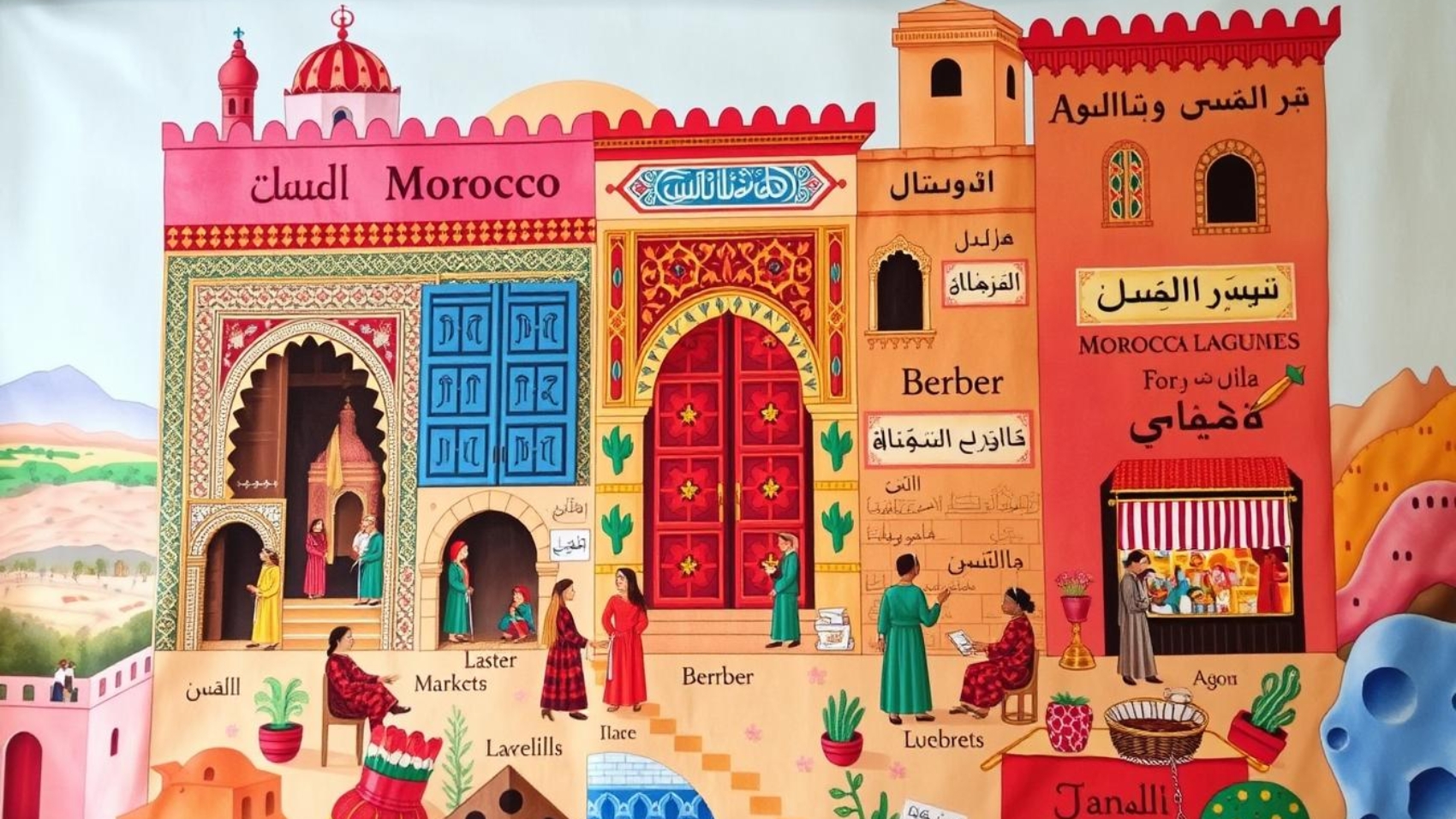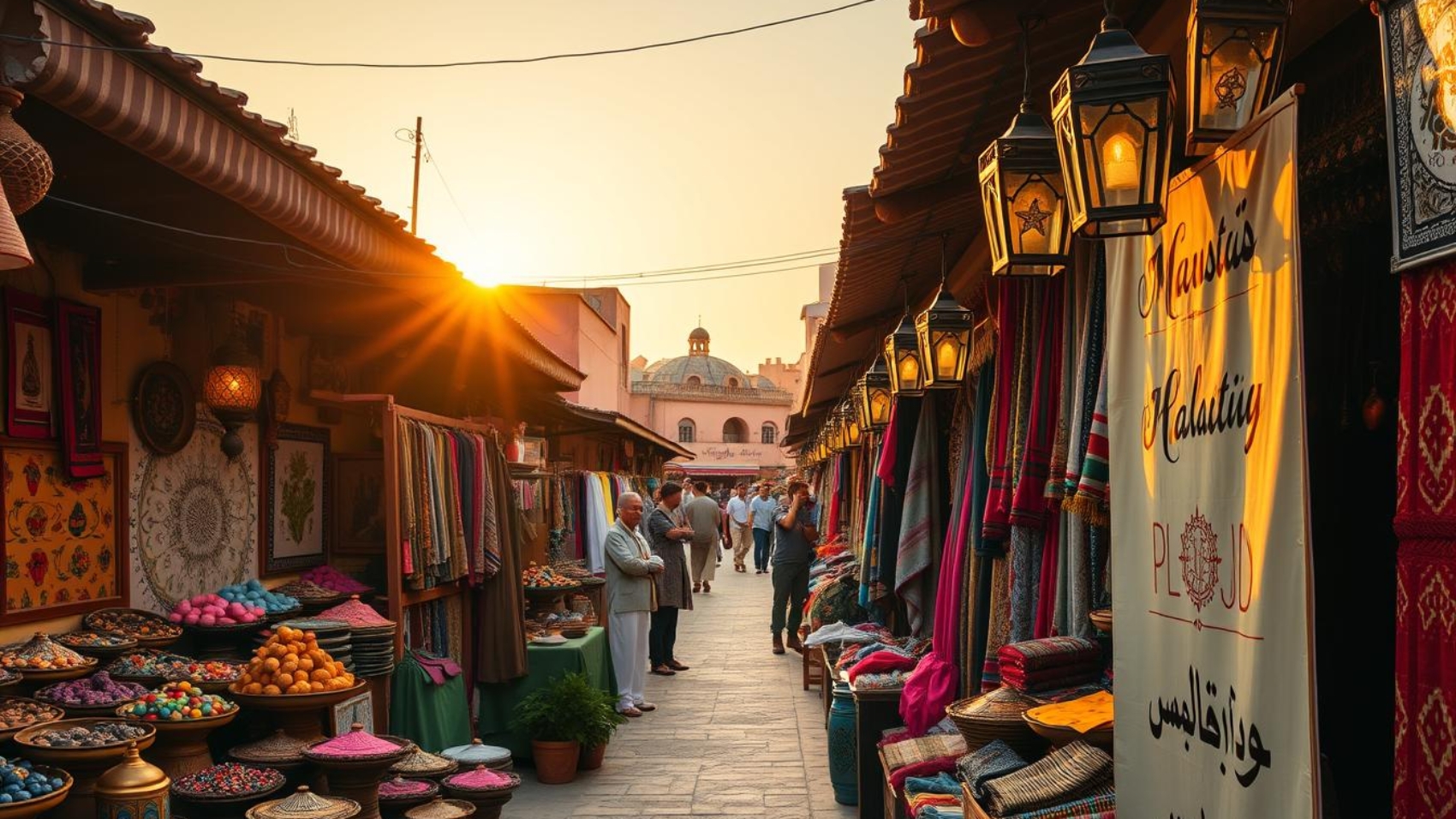Morocco is a country with a rich mix of languages. This reflects its complex history and culture. Arabic is a key language in the region.
But, the Amazigh languages are also important, with over 4 million speakers, Ethnologue says. These languages show Morocco’s diversity and cultural identity. They reflect influences from different civilizations and communities.
This article dives into Morocco’s language landscape. It looks at how these languages shape the country’s identity and place in the world. From Amazigh cultures to French and Spanish, each language reveals something special about Moroccan culture.
Introduction to the Linguistic Diversity of Morocco
Morocco’s language mix shows its rich history and diverse cultures. The country is a colorful mix of languages and dialects, each with its own tale. Morocco, at the crossroads of many cultures, blends *Arabic, Amazigh, and French* in a unique way.
About 49% of Moroccans speak Arabic, with many also using French. This mix reflects Morocco’s history and the complex relationship between culture and language. Trade, migration, and colonialism have made languages blend and influence each other.
In cities, dialects change fast. Amazigh languages, Arabic, and French all play a part, adding to Morocco’s cultural richness. Each language connects people across generations and communities, showing Morocco’s diverse identity.
The Official Languages of Morocco
The official languages of Morocco are key to the country’s culture and identity. They include Arabic and various Amazigh languages. Each language adds its own special touch to the national identity.
Arabic: The National Language
Arabic is Morocco’s national language, found everywhere in life. Modern Standard Arabic is used in formal settings, schools, and media. On the other hand, Moroccan Arabic, or Darija, is the go-to for everyday talks.
About 85% of people speak some form of Arabic. This shows how crucial Arabic is in shaping social life and cultural norms.
Amazigh Languages: The Indigenous Tongues
Amazigh languages, like Tamazight, Tarifit, and Tashelhit, are part of Morocco’s Berber heritage. The Moroccan government has officially recognized them. This highlights their importance in the national identity.
By promoting Amazigh languages, Morocco celebrates its diverse cultures. This enriches the country’s unique societal fabric.
Understanding the Morocco Language Landscape
The language scene in Morocco is rich and varied. It shows the country’s deep history and cultural mix. French and Spanish are big players, along with many local dialects that add to the country’s way of talking.
The Role of French in Moroccan Society
French is very important in Morocco. It’s used a lot in schools, business, and government. About 32% of people speak French as a second language. This shows Morocco’s close ties to France and how French has shaped local culture.
The Influence of Spanish in Northern Regions
In Morocco’s north, especially around Ceuta and Melilla, Spanish is very common. This is because of the area’s history and close location to Spain. Spanish is a big part of life in these cities, showing the cultural exchange that has shaped Morocco.
Other Minority Languages: A Look at Local Dialects
Morocco has many minority languages that show its ethnic diversity. Dialects like Hassaniya Arabic and Berber languages add a lot to the country’s language scene. They keep history alive and help communities keep their cultural identity.
Language and Culture in Morocco
In Morocco, language and culture are deeply connected. They are part of the country’s cultural identity. Different languages show different sides of Moroccan traditions. They help communities express themselves and connect with others.
The Connection Between Language and Identity
Language is key to both personal and national identity in Morocco. The country’s linguistic diversity lets people show their cultural identities. Proverbs and stories told in Arabic, Amazigh, or French carry the wisdom of past generations.
These stories show how language holds values, beliefs, and experiences unique to certain groups in Morocco.
How Languages Shape Cultural Practices
In Morocco, cultural practices like food, dance, and festivals often use specific languages. This highlights the role of language in rituals and community events. For example, traditional Moroccan music may have lyrics in many languages, showing the country’s multicultural nature.
Events like weddings or festivals use different languages to unite people. This creates a sense of belonging and celebrates Moroccan traditions.
Language Learning Opportunities in Morocco
Exploring Morocco’s language learning scene opens up many chances to improve your skills. You can choose from structured language schools or dive into immersive experiences. Online resources also help, making it easy for people everywhere to learn Moroccan languages.
Language Schools and Programs
Language schools in Morocco, like the Arabic Language Institute in Fez and Casa Árabe in Casablanca, are top picks. They have programs made for foreign students, focusing on Arabic and other local languages. You’ll learn from experienced teachers who guide you through the language learning process.
Immersive Experiences: Learning Through Travel
In Morocco, learning a language is all about experience. Programs mix language study with cultural activities. By living with local families, you get to practice your language skills every day. This way, you also learn a lot about Moroccan culture through daily interactions and events.
Online Resources for Language Learning
If you like learning at your own pace, online resources are perfect. There are many platforms and apps offering Moroccan language courses. They fit different learning styles and schedules, making it easy to start learning from anywhere.
Challenges Faced by Multilingual Speakers
In Morocco, speaking multiple languages comes with its own set of challenges. These challenges affect people of all ages and backgrounds. Understanding these issues is key to solving them. It’s about keeping the rich language diversity that makes Moroccan culture so vibrant.
Language Preservation Efforts
The Moroccan government is working hard to save the Amazigh languages. These languages are at risk due to Arabic and French. They’re making big steps to include Amazigh in schools and media. Here are some of their efforts:
- Adding Amazigh language classes in schools.
- Supporting cultural festivals that celebrate indigenous languages.
- Encouraging the creation of Amazigh literature.
These efforts help keep the languages alive and boost cultural pride.
Intergenerational Transmission of Languages
Keeping indigenous languages alive in families is tough. Young people often prefer Arabic and French. This makes it harder for languages to be passed down from one generation to the next. Families are crucial in this process, as the language spoken at home affects how well it’s kept alive. Challenges include:
- The preference for Arabic and French in education and media.
- Lack of resources for teaching indigenous languages at home.
- The social perception that indigenous languages have less economic value.
These issues make it hard for families to keep indigenous languages alive for the future.
Morocco Language in Global Context
The language scene in Morocco goes beyond its borders. It’s shaped by the Moroccan diaspora and global language trends. Seeing how these languages spread and change in different places helps us understand cultural preservation and identity.
The Global Diaspora and Language Use
The Moroccan diaspora is key in keeping Moroccan languages alive. People in places like France and Belgium use Arabic and Amazigh dialects. This keeps their cultural roots strong.
As Moroccans settle in new lands, they mix their native tongues with local ones. This mix ensures their cultural identities stay alive.
- Family gatherings stress the value of ancestral languages, shared with the young.
- Community events and cultural festivals help keep languages and cultures alive.
- Online spaces let people keep traditional expressions alive while fitting into today’s world.
Moroccan Languages in Academia and Research
Research on Moroccan languages shows their importance in studies around the world. Scholars look into how to keep these languages alive and how they change. This helps us understand global language trends better.
“Moroccan languages show a mix of cultural heritage and modern changes, making them key in language studies.”
Working together between Moroccan and international groups is vital. It leads to new research, language documentation, and sharing knowledge. This makes Moroccan languages more known and valued in schools and research worldwide.
Conclusion
Learning about Morocco’s languages is more than just talking. It’s about understanding the country’s rich history and culture. Arabic and Amazigh are official, while French and Spanish have a big impact. Each language shares a part of Morocco’s story and traditions.
Keeping these languages alive is key in today’s world. Morocco is working hard to protect its linguistic diversity. This shows the country’s dedication to its cultural heritage.
By valuing these languages, we learn more about Morocco. We also see how important diverse languages are for global understanding. This exchange enriches our world.
FAQ
What are the official languages of Morocco?
Morocco’s official languages are Arabic and Amazigh. Arabic is used in formal settings, like Modern Standard Arabic. But, Moroccan Arabic, or Darija, is common in daily talks.
The Amazigh languages, like Tamazight, Tarifit, and Tashelhit, are also key to Morocco’s culture.
How widely is French spoken in Morocco?
French is widely spoken in Morocco, with about 32% of people fluent. It’s a major second language, used in schools, business, and government.
Does Spanish have any significance in Morocco?
Yes, Spanish is important, especially in the north. Places like Ceuta and Melilla have strong Spanish ties. This is because of their colonial history.
What challenges do multilingual speakers face in Morocco?
Multilingual speakers in Morocco struggle to keep indigenous languages like Amazigh alive. Younger people often prefer Arabic and French over their native tongues.
How does language influence Moroccan culture?
Language deeply connects to Moroccan culture and identity. It’s seen in proverbs, stories, music, and traditions. This shows the rich diversity of Morocco’s communities.
Are there opportunities for learning languages in Morocco?
Yes, Morocco has many ways to learn languages. You can study at places like the Arabic Language Institute in Fez. Or, try immersive experiences like homestays.
Online resources are also available for learning Moroccan languages.
How are Moroccan languages represented in academia?
Moroccan languages are getting more attention in research. Scholars study their use, preservation, and dialects. There’s a growing interest in these languages globally.



